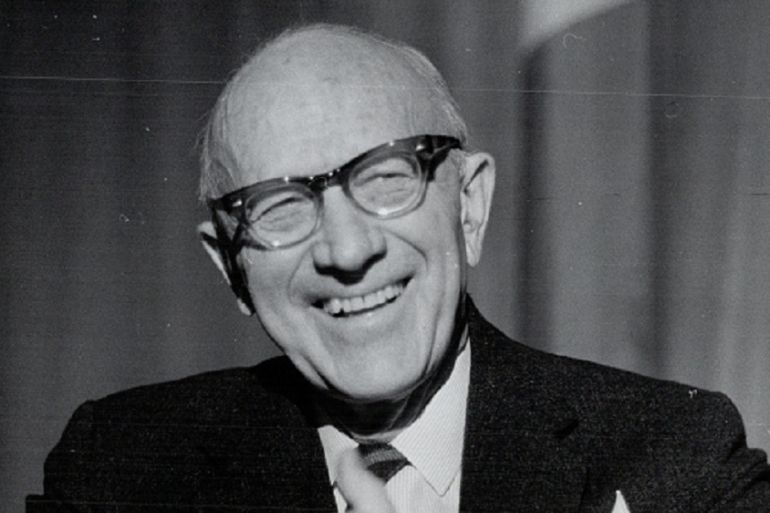Wilder Penfield: Why Google honours him today
Once described as the ‘greatest living Canadian’, Wilder Penfield would have been 127 years on January 26.

Once described as the “greatest living Canadian”, neurosurgeon Wilder Penfield would have been 127 years old on January 26.
Penfield is recognised for his advances in mapping the brain and for the groundbreaking epilepsy treatment known as the Montreal Procedure.
Keep reading
list of 4 itemsDeadly Sahel heatwave caused by ‘human-induced’ climate change: Study
Woman, seeking loan, wheels corpse into Brazilian bank
UK set to ban tobacco sales for a ‘smoke-free’ generation. Will it work?
Today, Google is changing its logo in 13 countries to a doodle, or illustration, in his honour.
Despite his success and achievements, he was not able to save his only sister, Ruth, who died from brain cancer, although complex surgery he performed added years to her life. This is his story:
Montreal’s first neurosurgeon
-
Penfield was born on January 26, in Spokane, Washington. His father, Charles Penfield, was a physician who didn’t succeed in his career.
-
His father left his family, and Wilder ended up living with his mother, Jean Jefferson, who is the one who told him about the Rhodes Scholarship that he ended up winning.
- He studied neuropathology at Princeton and Merton College in Oxford and then served at a military hospital in Paris. He also studied in Spain and Germany.
-
Penfield believed studying medicine was “the best way to make the world a better place.”
-
In 1917 he married Helen Kermott, who shared his altruism and love of helping others. Wilder and Helen had four children. One of his daughters also founded a children’s care centre.
- After taking a surgical apprenticeship, he obtained a position at the Neurological Institute of New York, where he carried out his first solo operation to treat epilepsy.
-
In 1928, Penfield accepted an invitation to move to Montreal, Quebec. There, Penfield taught at McGill University and the Royal Victoria Hospital, becoming Montreal’s first neurosurgeon.
-
In 1934, he became a Canadian citizen after he and Dr William Cone founded the Montreal Neurological Institute.
-
In 1935, he published three case studies describing the psychological effects of frontal lobe surgery.
- He used his experience treating his sister to explain the link between brain and behaviour. He said: “If she were alive, I am sure she would approve of such an analysis in the hope it would help others.”
-
He kept his family close throughout his career, writing the book Man and His Family, which stressed the need to nurture and encourage positive family life.
A fitting image! #WilderPenfield playing in the snow with his kids, 1922 from our Wilder Penfield Digital Collection https://t.co/hou3PwrCn1 pic.twitter.com/yA6ztq5kDY
— McGill Library (@McGillLib) February 15, 2017
Mapping the brain
-
In 1950, he experimented with using electrical probes to treat seizure activity in the brain while a patient was fully awake. Working with his friend and colleague, Herber Jasper, they developed what was known as the Montreal Procedure.
-
Mapping responses. As part of the procedure, the surgeon removes part of the skull and uses electrodes to stimulate the brain while the person is conscious with the intention of targeting the areas responsible for epilepsy.
-
The doctor mapped the responses in different parts of the brain.
-
Through this method, Penfield was able to map the brain’s sensory and motor cortices and show their connection throughout the body.
-
His first map was published in 1937, and a revised version was published in 1950. Those maps are still used today, nearly unaltered.
-
Penfield’s contributions to modern neuroscience raised Canada’s status in healthcare, science, and discovery while his innovations gave people with epilepsy better lives.
https://twitter.com/Passport2017/status/816758198917021697?ref_src=twsrc%5Etfw
Le Dr Wilder Penfield, à l'âge de 73 ans, dessinant une coupe du cerveau humain, 1963 pic.twitter.com/VipXDhNhBm
— Photos Histoires (@PhotosHistos) November 1, 2014
Recognition
-
Penfield became an author and a champion of university education. He was appointed to the Order of Merit in 1953.
-
In 1960, he was awarded the Lister Medal for his contributions to surgical science.
-
In 1961 he delivered a Lister Oration, “Activation of the Record of Human Experience,” at the Royal College of Surgeons in England.
-
In 1967 he was named a Companion of the Order of Canada, and in 1994, he was posthumously included into the Canadian Medical Hall of Fame.
-
Much of his archival material is kept in the Osler Library at McGill University.